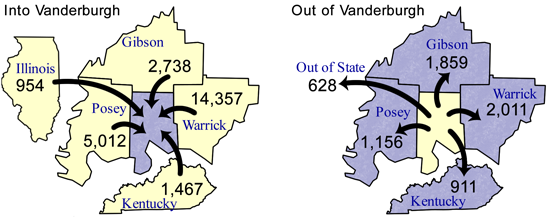Gibson Is Gone (and So Is Webster)
A statistical tragedy struck Indiana in February 2013. The revised delineations for metropolitan and micropolitan statistical areas were released by the federal Office of Management and Budget (OMB) and the Evansville metro area lost Gibson County (home to Toyota) and Webster County in Kentucky.
Why a tragedy? In market research and site locator circles, the metropolitan area is a primary focal point for them. Researching and comparing about 300 areas (compared to 3,100 counties) makes their work a bit easier. Whether this approach is good or bad will not be the subject here (although we would point these folks to the USA Counties in Profile where they can easily find comparable data for all counties nationwide).
Gibson and Webster counties should not have been removed from the Evansville metro area definition. Gibson County has become even more “integrated” (see previous article) in the fabric of the core city of Evansville and both Webster and Henderson counties in Kentucky have historical and current economic and social ties to Evansville.
The loss of Gibson County as part of the metropolitan area AND as a “crossover” county among the many micropolitan areas it is adjacent too, is the most egregious. Gibson County is home to one of the largest auto assemblers in the state and the beneficiary of the many suppliers that have located in Gibson and other nearby counties. Looking at our most recent commuting data, we can see the large volume of commuters shuffling between Gibson and Evansville’s core county (see Figure 1).
Figure 1: Vanderburgh County’s Top Five Commuting Relationships, 2011

Source: STATS Indiana Commuting Profile
Considering that commuting is a key consideration for OMB in its guidelines, we are left to wonder what information they used that caused them to shrink this metro area. Since the decennial census no longer yields commuting data, we will perhaps consider turning our attention in future articles to the pitfalls of using the American Community Survey five-year estimates to determine these important definitions.
We shouldn’t take this. What we should and can do is let the OMB know that this is a mistake and that correcting it sooner rather than later is a necessary action.
You can submit your comments about this issue via this web form (OMB is part of the White House): www.whitehouse.gov/contact/submit-questions-and-comments.
